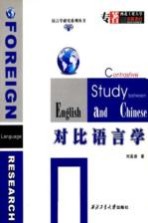

对比语言学PDF电子书下载
- 电子书积分:9 积分如何计算积分?
- 作 者:刘美岩著
- 出 版 社:西安:西北工业大学出版社
- 出版年份:2010
- ISBN:9787561227480
- 页数:192 页
Chapter One Contrastive Analysis 1
1.1 What Is Contrastive Analysis 1
1.2 Background of Contrastive Analysis 1
1.3 Rationale for Contrastive Analysis 3
1.4 Theoretical Assumptions of Contrastive Analysis 3
1.5 Theoretical Basis of Contrastive Linguistics 4
1.5.1 Psychological Basis of Contrastive Analysis 4
1.5.2 Linguistic Basis of Contrastive Analysis 7
1.6 Application of TG Grammar to Contrastive Analysis 10
1.7 Pedagogical Applications of Contrastive Analysis 11
1.8 Criticisms of Contrastive Analysis 11
Chapter Two Error Analysis 13
2.1 What Is Error Analysis 13
2.2 Rationale for Error Analysis 13
2.3 Theoretical Assumptions of Error Analysis 14
2.4 Claims of Error Analysis as a Primary Pedagogical Tool 14
2.5 Describing Errors 15
2.5.1 Error VS.Mistake 15
2.5.2 Levels of Errors 15
2.5.3 Types and Causes of Errors 20
2.6 Techniques for Systematic Error Analysis 23
2.6.1 Introduction 23
2.6.2 Procedures 23
2.7 Computerized Corpora of Errors 29
2.8 Pedagogical Applications of Error Analysis 29
2.9 Modern Contrastive Linguistics and Its Significance 31
Chapter Three Contrastive Study between Chinese and English in Phonology 33
3.1 What Is Phonology 33
3.2 Phonological Analysis 33
3.3 Two Phonological Models 34
3.3.1 Taxonomic Phonology 34
3.3.2 Generative Phonology 34
3.4 Differences between Chinese and English in Phonology and Difficulties Involved in Learning 34
3.4.1 Differences in Syllable Structure and the General Pattern of Distribution of Consonants and Vowels in the Two Languages 35
3.4.2 Differences between Chinese and English in Consonants and Difficulties Involved 38
3.4.3 Differences between Chinese and English in Vowels and Difficulties Involved 40
3.5 Tones and Intonation 42
3.5.1 Tones in Chinese Language 42
3.5.2 Tones and Intonation in English 42
3.6 Linking in English 43
3.7 Assimilation of Sounds in English 43
3.8 Incomplete Plosives in English 44
3.9 Stress 45
3.10 Difficulties Involved in Learning 46
Chapter Four Contrastive Study between Chinese and English in Lexicology 47
4.1 What Is Lexicology 47
4.2 Word Formation of Chinese and English Language 47
4.2.1 Word Formation of Chinese Language 48
4.2.2 Word Formation of English Language 53
4.3 Idioms,Slangs and Colloquial Expressions in Chinese and English 55
4.3.1 Cheng Yu(set phrases)in Chinese 55
4.3.2 Colloquial and Idiomatic Expressions in Chinese 58
4.3.3 Idioms,Colloquialisms and Slangs in English 60
4.4 Sense Relationship in English and Chinese Language 63
4.4.1 Syntagmatic Semantic Relationships 64
4.4.2 Paradigmatic Semantic Relationships 67
4.5 Semantic Field(Semantic Domain/Lexical Field/Word Field) 69
4.5.1 What Is Semantic Field 69
4.5.2 Contrastive Study between English and Chinese in Color System 70
4.6 Coincidence,Parallel and Lexical Gap between English and Chinese 73
4.6.1 Coincidence 73
4.6.2 Parallel 75
4.6.3 Lexical Gap 76
4.7 Difficulties Involved in Learning 79
Chapter Five Contrastive Study between Chinese and English in Grammar 82
5.1 What Is Grammar 82
5.2 Morphological Contrastive Study 82
5.2.1 Aspect in English and Chinese 82
5.2.2 Tense in English and Chinese 83
5.2.3 Case in English and Chinese 84
5.2.4 Gender in English and Chinese 85
5.2.5 Mood in English and Chinese 85
5.2.6 Person in English and Chinese 88
5.2.7 Part of Speech in English and Chinese 88
5.3 Syntactic Contrastive Study 99
5.3.1 Commonly Used English Sentence Patterns 100
5.3.2 Commonly Used Chinese Sentence Patterns 101
5.3.3 English Complicated Sentences 110
5.3.4 Chinese Complicated Sentences 114
5.4 Differences between English and Chinese Sentences 121
5.4.1 Differences in Word Order 121
5.4.2 Hypotactic(English)VS.Paratactic(Chinese) 123
5.4.3 Compact(English)VS.Diffusive(Chinese) 124
5.4.4 Subject-predicate Structure(English)VS.Topic-comment Structure(Chinese) 127
5.5 Implications for Translation 128
5.5.1 Chinese to English Translation 128
5.5.2 English to Chinese Translation 132
5.6 Implications for Language Teaching 133
5.6.1 English Language Teaching 133
5.6.2 Chinese Language Teaching 136
Chapter Six Contrastive Study between Chinese and English at Text Level 142
6.1 What Is Text and Text Linguistics 142
6.1.1 Cohesion 144
6.1.2 Coherence 146
6.2 Differences between English and Chinese in Text Cohesion 148
6.2.1 Differences in Reference 149
6.2.2 Differences in Ellipsis 151
6.2.3 Differences in Conjunctions 152
6.3 Related Studies Concerning the Differences between English and Chinese in Text Rhetoric(Coherence) 154
6.3.1 English Directness VS.Chinese Indirectness 154
6.3.2 Differences between English and Chinese in Choosing Supporting Materials 162
6.3.3 Pedagogical Implications for Chinese ESL Teaching 164
Chapter Seven Contrastive Study between English and Chinese in Styl istics—from some aspects 167
7.1 What Is Style and Stylistics 167
7.2 Stative Characteristic of English VS.Dynamic Characteristic of Chinese 168
7.2.1 Preponderance of Nouns over Verbs in English 168
7.2.2 Preference of Preposition Constructions to Verbs in English 171
7.2.3 Tendency of Agentive Nouns over Verbs in English 172
7.2.4 Tendency of Adjectives over Verbs in English 172
7.2.5 Inclination of Feeble Verbs in English 173
7.2.6 Verb Preponderance in Chinese 173
7.3 Impersonal Style of English VS.Personal Style of Chinese 175
7.3.1 Passive Voice in English 175
7.3.2 Differences between English and Chinese in Using Passive Voice 179
7.3.3 Impersonal Subject of English VS.Personal Subject of Chinese 181
7.4 Implications for Translation 183
7.4.1 A Shift from English Stative Diction to Chinese Dynamic Diction 183
7.4.2 A Shift from Chinese Dynamic Diction to English Stative Diction 184
7.4.3 A Shift from English Passive Expression to Chinese Versions 185
Bibliography 189
- 《程序逻辑及C语言编程》卢卫中,杨丽芳主编 2019
- 《幼儿园课程资源丛书 幼儿园语言教育资源》周兢编 2015
- 《高等学校“十三五”规划教材 C语言程序设计》翟玉峰责任编辑;(中国)李聪,曾志华,江伟 2019
- 《音乐语言的根基》张艺编著 2019
- 《英汉轻动词对比研究》朱乐奇著 2019
- 《认知语言学视野的抽象方位结构研究》曹爽著 2019
- 《激活语言思维》李蒨,王宏年,汤青编著 2017
- 《汉语言文学本科专业核心课程研究导引教材 古代汉语》马蓝婕责任编辑;(中国)魏宜辉 2019
- 《国内外辐射环境监测体系对比研究》上海市辐射环境监督站 2019
- 《英语教师语言意识研究》秦莉,赵春贺著 2019
- 《中国古典舞扇舞研究》胡岩著 2019
- 《新时代马克思主义新闻观七讲》董岩著 2019
- 《零基础学拔罐》杨秀岩著 2018
- 《新零基础学刮痧》杨秀岩著 2018
- 《罗特小说集 7》(奥地利)约瑟夫·罗特著;徐庆,刘美珅,吴麟绶,孙爱群译 2019
- 《数据分析与云计算技术研究》闫岩著 2019
- 《西游记那些事》自在岩著 2018
- 《心灵治疗与宇宙传统》仁表著;刘美伶译;李辛校 2018
- 《改革开放40年中国教育学科新发展 教育技术学卷》刘美凤主编 2019
- 《精纺毛织物生产技术教程》潘峰,王文志,刘美娜 2018
